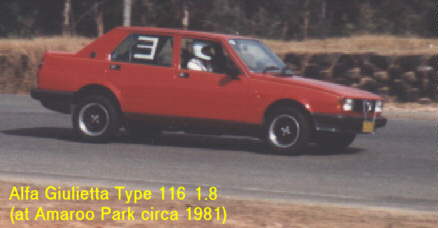
Index
Get a life! Or one person's diatribe on staying alive. Skippable.
Handling 101 - What's handling good for?
Handling 102 - Let's get technical about handling
Handling 103 - Adjusting your car's handling characteristics
Tyre pressures matter
Camber plays a part
Sometimes you must Toe the line!
Caster look over 'ere, mate!
Having a Polar Moment
Roll Over Beethoven
Oversteer
Understeer
Weight transfer explained
Shuffle off this mortal Coil
Tyres and Wheels can do more than just look good
Pitching a fast ball
Other stuff people often don't understand
Heel and Toe
Double declutch
Wheel offset
Rollbars
CVT - Constantly variable transmission
Twin camshaft motors
GTV - Grand Touring Veloce
GTi - Grand Touring Injection
GTam - Grand Touring America or maybe Allegerita Modificato
RS - Rally Sport or Renn Sport
GTO - Grand Touring Omologato
If you are reading this from go to whoa then by now you will be wondering how any reasonable compromise can ever be struck between all of these handling factors. It's not easy! That's why there is diversity both in the automotive marketplace and on the race track. No one car and handling setup will meet every need (although programmable active suspension will conceivably change all of that, when it is finally available at reasonable cost).
So now, what about this roll business? Let's talk about roll axis briefly. If you took a centre point as far aft as you can go on your car's rear suspension, perhaps halfway along your Panhard rod if you have one (Opel Kadett/Holden Gemini and Alfa Romeo Alfasud are examples) and called that "a". Or if you have a Watts linkage like on an Alfetta then that would be the rearmost point and the pivot point is then the "a". Or if you have a tube or u-beam between your rear wheels like many front-drive cars, just pick dead centre on that as your "a". Then look forward at the control arms or other wheel-controlling suspension pieces that run forwards from the wheel hub and angle inwards towards a fixing point on the car body. Draw a line from each rear wheel along that control arm and extend it until both lines intersect. That's "b". It could be higher, lower or on the same plane as "a".
From a to b is your roll axis. Your car's bodywork will tend to roll around this axis as it corners. If your roll axis falls towards the front of the car then that's an understeering roll axis. Which is to say that the front of the car reacts increasingly less to your steering inputs and you simply, in extremis, run out of road. Symptoms include that "straight-ahead" feeling, where you want to turn but the car doesn't, and lots and lots of steering wheel turning, to no great effect. Also known as front tyre scrub, this is a fairly safe handling characteristic and is often preferred over a car that wants to switch ends!
Personally, I prefer a generally understeering car that can be tricked into oversteer at times of my choosing. Front drives are good, in that they will understeer under power but, especially the short-wheelbase models, can be provoked into oversteer by lifting off the throttle.
Roll stiffness is important as well in controlling the forces involved. Look at the location of your car's springs. If they are as close to the wheels as possible, i.e. spaced wide-apart, then the effect is of high roll stiffness. Relatively close together, like on an Alfetta, gives low roll stiffness. Now you know why Alfettas have so much body roll!
Whilst we are on the topic of roll stiffness, it is an effect that occurs front or rear. The springs themselves will have a value, a spring rate, that influences the way that the car responds to corners, weight transfers and bumps in the road. Too stiff and the car may bounce instead of following the road. Or lift a wheel under hard cornering. Whilst this isn't a tragedy, it's not ideal. The more time a tyre spends in contact with the road, the more it can assist in providing grip. Wheel lifting causes camber changes and is generally not good. Particularly if you find that you are lifting a driving wheel!
You can change the roll stiffness of your car by adding stabiliser bars or by stiffening the springs. Or cut the suspension out and design a whole new one (just kidding, although - yes - people will do it if they are totally committed to one machine and wouldn't dream of buying a new one). However you do it, the benefit is that you can tune your handling. Stiffen the front and soften the rear to get oversteer, the reverse for understeer. By adjusting or tuning in this way the degree of roll stiffness front and rear you can dial up the characteristics you want. If you race you may want to adjust the setup for each race circuit in order to get the best result. Adjustable stabiliser bars make this easier of course; cockpit controls are ideal, so you can adjust for changing conditions, fuel load and so on.



